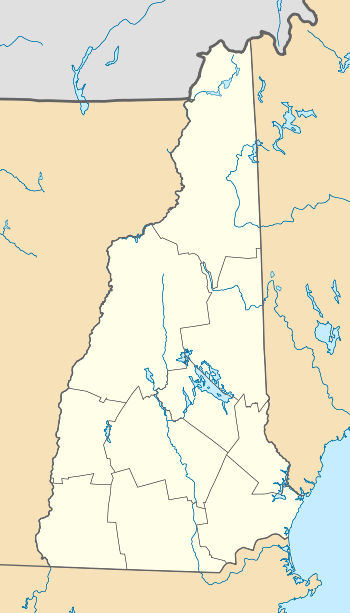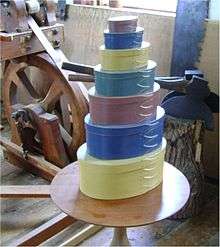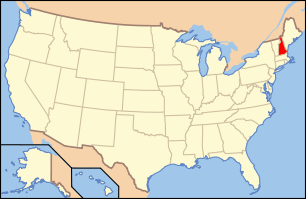Daniel Cragin Mill
The Daniel Cragin Mill, known today as the Frye's Measure Mill, is a historic watermill established in 1858. The mill is about three miles (5 km) west of the small town of Wilton in Hillsborough County, New Hampshire. For over 150 years the mill's production has been unique woodenware and wooden boxes used for dry measuring boxes. Presently the mill's main production is Shaker-style pantry boxes and furniture pieces for the various Shaker communities and their museum gift shops. The mill was added to the U.S. National Register of Historic Places in 1982.
Daniel Cragin Mill | |
 12 Frye Mill Road | |
  | |
| Location | west of town of Wilton at the junction of Davisville Road and Burton Hwy |
|---|---|
| Nearest city | Wilton, New Hampshire |
| Coordinates | 42°51′22″N 71°47′20″W |
| Area | 4 acres (1.6 ha) |
| Built | Originally built 1817 Mill founded 1858 |
| Architectural style | water-powered mill Colonial (1600-1820) |
| NRHP reference No. | 82001681[1][2] |
| Added to NRHP | March 23, 1982 |

History
Daniel Cragin era of 1858–1909
Daniel Cragin was of Scottish descent. At the age of 21 in 1856 he was renting a room in the Putnam Bobbin Factory near the present day Frye's Measure Mill. Here he made knife trays and wooden toys that he turned into a full-time business. His initial cash investment to start the business was ten dollars. He soon turned a profit and in 1858 he purchased an existing small building at this site that eventually became known as the Daniel Cragin Mill. The watermill was run on water power that came from two nearby water sources, Burton Pond and Nathan Barker's Pond. The building was originally built by Eliphalet Putman in 1817.[3][4]
By 1878 Cragin had added sugar boxes and dry measure boxes and had hired six others into his normal mill operations.[5] He soon made mostly dry measure boxes which was the main part of his millwright enterprise at this Wilton location since it was more profitable. His hand made round containers were made in five sizes. These were one quart, two quart, four quart, single peck, and one-half bushel. Because of his success in sales by 1885 Cragin began selling these in full sets, or "nests", that were bound in iron bands. The dry measure volume containers sold varnished, plain, and rough, depending on customer wants.[4]
Storekeepers, farmers, and fishermen needed a standard unit of dry measure for their trade products. This was so they could transact and carry on negotiations of their various commodities for bartering and selling. In the later part of the nineteenth century Cragin's reasonably priced dry measure containers were in much need for these various commercial entrepreneurs. He was able to sell many containers and full set "nests" in the later part of the nineteenth century and the first part of the twentieth century. Sometime later the national standard of measurement switched over to weights and the market for his dry measure containers used to measure units of volume of bulk commodities came to an end.[4]
Cragin made a specialty type measure called a "piggin", which was a small wooden pail with a handle formed by continuing one of the staves above the rim. The wooden dipping pail was used for dyes in southern textile factories.[6] Before the time electricity was readily available, the mill supplemented its needs with an 1871 one-cylinder steam engine for additional heat, to operate the kilns, and for additional energy for the steam vats. The antique engine is still at the premises of the mill.[7]
Whitney Frye era of 1909–1960
In 1909 Whitney Morse Frye with his father, Dr. Edmund Bailey Frye, bought the mill from Daniel Cragin. The name of the mill then became E.B. Frye & Son. Frye was educated in engineering at Lowell Textile Institute and Dartmouth College and received an engineering degree. With this knowledge he redesigned and invented machinery and techniques for modern use to make the mill more productive. Frye continued the Cragin line of wooden trays, boxes, and pails in addition to his normal processing of grains. Later he added curry cards (combs for cattle), wool cards, ice cream freezers, and Shaker-style pantry boxes.[8]
Frye added hydroelectric power to the mill sometime later. This was done by improving the existing water-power system to include a series of pipes from Burton Pond and Nathan Barker's Pond to provide a controlled water force, or "head", to maintain a system to generate electricity. It furnished the mill's electrical needs as well as the electricity for Frye's nearby house.[8]
Harland Savage Sr. era of 1961–1981
Harland Savage Sr. was first employed as a part-time worker after World War II at the mill. He was soon promoted to a full-time employee and then in 1951 to the general manager of the mill. In 1961 he purchased the mill and operated it until 1981 when he retired. At that time his son Harley and his wife Pam Porter Savage took over operations. They have operated Frye's Measure Mill to the present day.[9]
In the late 1960s Shaker eldress Bertha Lindsay of the Canterbury Shaker Village asked Harland Savage Sr. if he would be interested in making Shaker-style oval boxes since their last skilled pantry box maker died in 1961. Frye's Measure Mill then added Shaker style boxes to their line of Colonial boxes and distribute to all the Shaker communities for their gift shop sales.[10]
Frye's Measure Mill, originally the Daniel Cragin Mill, is the only remaining operating water-powered measure mill in the United States after some 150 years of operations.[6][11][12] A self-guided mill tour is available in warmer months.
See also
- Hamblet-Putnam-Frye House, the Frye's summer residence located west of the mill
- National Register of Historic Places listings in Hillsborough County, New Hampshire
References
- "National Register Information System". National Register of Historic Places. National Park Service. July 9, 2010.
- "New Hampshire's 2008 Seven to Save" (PDF). New Hampshire Preservation Alliance. Retrieved January 28, 2019.
- Dell'Orto, p. 28
- "Frye's Measure Mill Founder: Daniel Cragin 1837–1922". Frye's Measure Mill. Retrieved January 28, 2019.
- Livermore, p. 171
- "'Confrontation' with bull killed Hampton Falls man". unionleader.com.
- Adamowicz, pp. 66–67
- "The Whitney Frye Era 1909-1961: Building the Self-Contained Mill". Frye's Measure Mill. Retrieved January 28, 2019.
- "The Harland Savage, Sr. Years. The Skill of the Millwright, Handed Down 1948 to Present". Archived from the original on 2008-05-13. Retrieved 2009-04-25.
- "Frye's Measure Mill". fryesmeasuremill.com.
- Wilton measure mill celebrating 150 years Thu, 14 Aug 2008 22:37:00 EST
- "Monadnock Ledger-Transcript, Peterborough, NH. Serving the Heart of the Monadnock Region. - Ledger Transcript". ledgertranscript.com. Archived from the original on 2015-05-30.
Sources
- Adamowicz, Joe, The New Hiking the Monadnock Region: 44 Nature Walks and Day-Hikes in the Heart of New England, Publisher UPNE. Published 2007. ISBN 1-58465-644-1
- Dell'Orto, Michael G. et al., Wilton, Temple, and Lyndeborough, Arcadia Publishing, Published 2003. ISBN 0-7385-1220-6
- Livermore, Abiel Abbot et al., History of the Town of Wilton, Hillsborough County, New Hampshire, Marden & Rowell Printers. Published 1888. Lowell, Massachusetts
External links
| Wikimedia Commons has media related to Frye's Measure Mill. |
